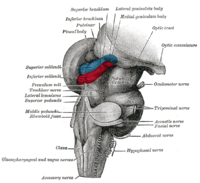
Photo from wikipedia
In the mature human brain, the neural processing related to different body parts is reflected in patterns of functional connectivity, which is strongest between functional homologs in opposite cortical hemispheres.… Click to show full abstract
In the mature human brain, the neural processing related to different body parts is reflected in patterns of functional connectivity, which is strongest between functional homologs in opposite cortical hemispheres. To understand how this organization is first established, we investigated functional connectivity between limb regions in the sensorimotor cortex in 400 preterm and term infants aged across the equivalent period to the third trimester of gestation (32-45 weeks postmenstrual age). Masks were obtained from empirically derived functional responses in neonates from an independent data set. We demonstrate the early presence of a crude but spatially organized functional connectivity, that rapidly matures across the preterm period to achieve an adult-like configuration by the normal time of birth. Specifically, connectivity was strongest between homolog regions, followed by connectivity between adjacent regions (different limbs but same hemisphere) already in the preterm brain, and increased with age. These changes were specific to the sensorimotor network. Crucially, these trajectories were strongly dependent on age more than age of birth. This demonstrates that during the perinatal period the sensorimotor cortex undergoes preprogrammed changes determining the functional movement organization that are not altered by preterm birth in absence of brain injury.
Journal Title: Human brain mapping
Year Published: 2022
Link to full text (if available)
Share on Social Media: Sign Up to like & get
recommendations!